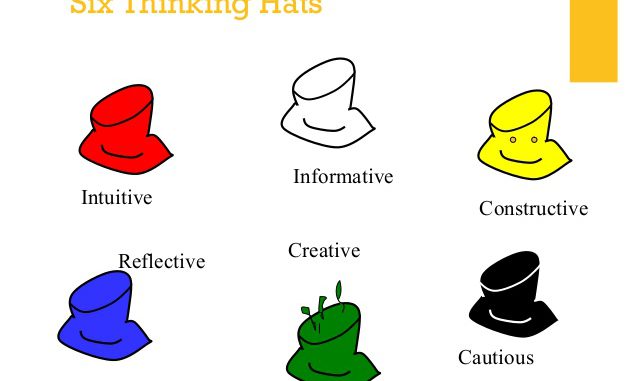
What is it?
The thinking hats activity originates from Edward De Bono’s (1985) Six Thinking Hats book about the process of lateral and creative thinking. It is largely associated with Business Management, but can be adapted for all disciplines, modules or subjects where there is some level of critical analysis, reflection on action, or exploration of decision making.
Students look at one problem or situation from different ways of thinking, represented by coloured ‘hats.’ It is different from pinwheels (link) in that it is based on a philosophy of thinking and therefore focuses on ways of considering a task or problem rather than creating an argument from different people’s perspectives/opinions or sides.
Edward De Bono explains:
Why do it?
Although this orignated as a leadership training package online, De Bono’s thinking hats concept has been adopted within higher education to teach students creative and critical thinking and how to build solutions based on in-depth understanding to problems. It is directly applicable to modules which have problem-based learning as a core learning outcome or method of instruction.
De Bono (1992) says that “confusion arises when we try to do too much at once [but] the six hats method allows us to take one direction at a time” (p. 8). The idea is that wearing of a different coloured hat enables the wearer to bring a different perspective to thinking critically about an issue and to trying to find alternative solutions to any problem confronted.
It can be used as a substitute for discussion, debate or argumentation in classes where there may be or may have been conflict due to the make-up of the group or the sensitivity of the topic. It can be a way of desensitising and exploring issues such as race and inclusion.
How to set it up
- Explain the purpose of the activity, set the topic and go through the hats’ meanings.
- Stipulate that they must stick to their ‘hat’ for the duration of the discussion.
- Explain that the point is not for one ‘hat’ to ‘win’ or dominate.
- Have students either pick a ‘hat’ or you can allocate them. Explain the purpose of the hat and preferably concept check understanding of that type of thinking using some key questions in the table below.
- You can have the students in ‘hat groups’ for larger classes (see pinwheel set up) or you can have different groups of 6 students only around the room (see fishbowl or jigsaw set ups). The choice will depend on your judgment of the students’ confidence in speaking situations, familiarity with the exercise etc (see Considerations’ below)
The White Hat calls for information known or needed. Questions might include:
- What facts, data, and information do we have?
- What facts, data, and information do we need?
- What information is missing?
- What do the data reveal?
- What is the methodology for obtaining the facts and data needed to reach a solution?
The Black Hat is judgment – the devil’s advocate or why something may not work. Questions include:
- What are the weaknesses?
- What may go wrong if we implement this suggestion?
- What are the potential problems?
- Do we have the resources to do it?
The Red Hat signifies feelings, hunches and intuition. Questions include
- Based upon my emotions, what is my commitment level to the issue?
- How do I feel about a decision I might make?
- What is my intuition regarding this issue?
The Green Hat focuses on creativity; the possibilities, alternatives, and new ideas. Questions include:
- What alternative solutions are possible?
- Could a recommendation be done in another way?
- What is a unique way of looking at the issue?
The Blue Hat is used to manage the thinking process. This hat is the facilitator. Questions include:
- Where do we start?
- What sequence of hats will be most appropriate?
- How much time should be allocated to each hat?
- What is the action plan for next steps, roles, responsibilities and time frame?
Adapted from: http://www.debonogroup.com/six_thinking_hats.php and https://mtprof.msun.edu/Fall2010/hats.html.
Considerations
- It can easily be used in e-learning for discussion forums or online webinars.
- This does not require much pre-class planning on behalf of the teacher, but will take time within in class to ensure it is successful. Teachers should explain the purpose of the activity and model the use of the technique for students and then offer guided practice in either whole group or team settings. Be aware that this type of activity and way of analysing thinking processes is quite Western-centric and not necessarily readily accessible to all students without guidance.
- Consider who allocates ‘hats.’ Sometimes it is good to let students’ volunteer, although because the purpose of the activity is to foster diffident modes of thinking and behaving, it can be more rewarding and challenging to allocate roles for students.
- Some consider this a little cliched nowadays as it has become commercialised and used in corporate leadership training. Some students or teachers might find this alienating. Encourage students to reflect on their experience with the activity afterwards.
Examples/Variations:
Kivunja (2015) gives a very detailed example of how to use the thinking hats activity to explicitly teach critical thinking in higher education for the 21st Century world.
Karadag et al (2009) discuss the use of the thinking hats in NURSING.
Zhang et al (2018) have used thinking hats as a reflecting debriefing exercise after medical simulations.

Leave a Reply